Uncovering the history of the Peranakan is written in response to comments on a Facebook thread discussing the identity of the Penang Baba Nyonya, from my other article, Are you Baba Nyonya? The original article is about the Baba Nyonya of Penang. This article discusses the Peranakan Chinese of Malacca and Penang; it is not within the scope to include the Chitty and Jawi Pekan.
To understand and appreciate the Baba Nyonya heritage, we have to question and some times even reject the widely accepted notion of who they are, even if that notion originated from an authoritative figure. From the 19th century until present time, the identity of the Baba Nyonya has been distorted due to misunderstanding or lack of knowledge, so much so that we are buying in on the distortion today. I want to point out a few characteristics which we should take note.
The Baba Nyonya of Penang and Malacca are two distinct groups. They don't share the same historical characteristics. For lack of specific terms to differentiate the Peranakans of Malacca and Penang, I shall accept the use of Baba Nyonya and Peranakan interchangeably.
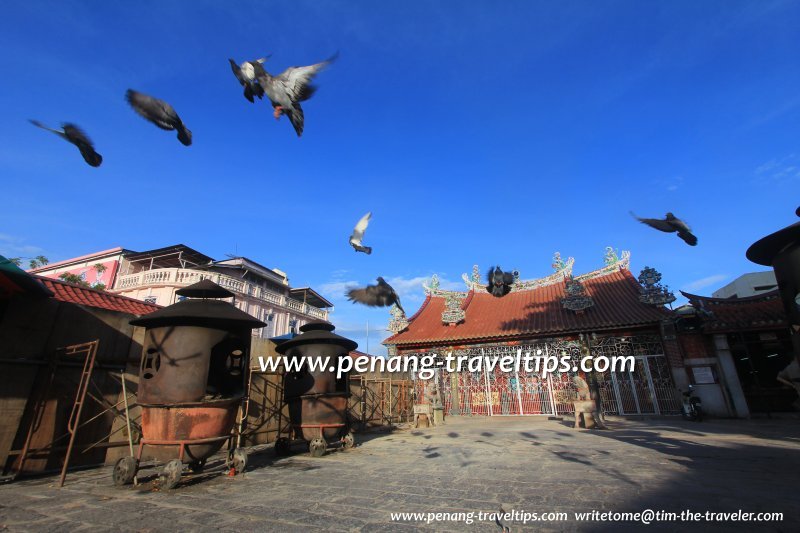 Kuan Im Teng Temple, George Town, Penang (5 February 2013)
Kuan Im Teng Temple, George Town, Penang (5 February 2013)
Secondly, we should not lump them with the Chitty and Jawi Pekan (despite the generally accepted use of Peranakan on them, such as Peranakan Jawi). To me, when we lump people together, we introduce a distortion to their heritage and glaze over our understanding of their differences. This is an injustice to each of them. Such lumping together will not help us better understand their individual characteristics, because we end up looking for similarities instead. Broad generalisation is used by people who don't care to understand deeper, so terms such as Peranakan, Orang Asli, Asians, Caucasions are used to collectively denote groups of people of disparate characteristics.
"Straits Chinese", "Straits-born Chinese". These terms have been around since the time of the British, but the Baba Nyonya and Peranakan have been here much longer, before the British established the Straits Settlements. What did happen under the British was a more ostentatious display of the Peranakan culture brought about by an increased in their wealth. This happened mostly in the 19th century. But before that, they were already living in pocket settlements along the coast, but existing on a lower profile. What did happen was that, after the Straits Settlements were established, they gravitated there for better economic opportunities. And their business acumen worked well to their advantage, advancing them far ahead of other locals. They have a nose for prosperity. When Singapore was established, many had no qualms to relocate there from Malacca.
The British introduced a distortion by calling them Straits Chinese or Straits-born Chinese. The British probably did not care to learn more about them, other than, they were living in the Straits Settlements, and they were very different culturally from the newcomers. Hence the term Straits Chinese was applied liberally to differentiate them from the Sinkheh. In fact, the Peranakan had been around and their culture had been in incubation long before the term Straits Chinese was applied to them. That we should be aware. Otherwise, we may be misled into thinking that the history of the Baba Nyonya and Peranakan began in the Straits Settlement and not earlier.
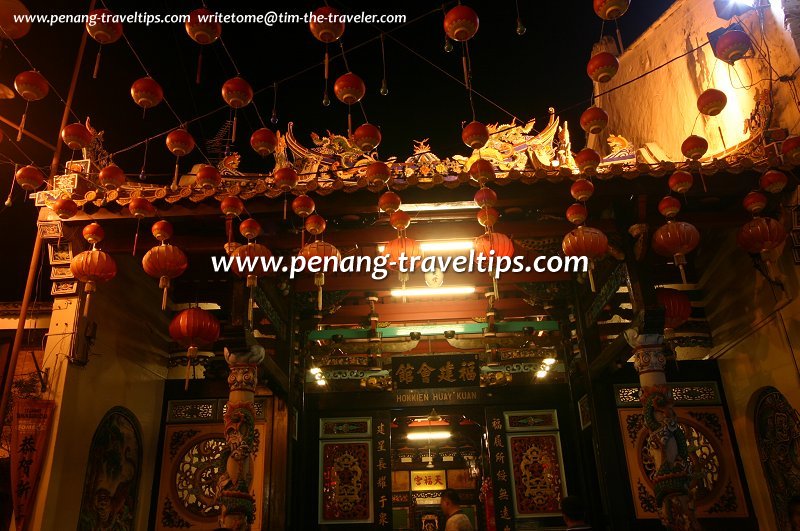 Hokkien Huay Kuan, Malacca (9 July 2005)
Hokkien Huay Kuan, Malacca (9 July 2005)
"The Peranakan is the product of intermarriage between the Chinese and the local races." This, to me, is another distortion that has blurred our understanding of the Baba Nyonya and Peranakan. Chinese people marry other races all the time, even today. You don't see your intermarriage friends creating a new, distinct group, do you?
A point to note here is that the Peranakan was not created by the intermarriage. They have already been practising their Peranakan culture when they intermarry other races. And the intermarriage is carried out on their terms. Other races marry into them and take on their customs. It's not Chinese+Other Races=Baba Nyonya.
It is Baba Nyonya+Other Races=Baba Nyonya. And the intermarriage, at least during the 19th and early 20th century, happened only between the male Baba and a female of other races. Of course there would be exceptions to all rules, but we are talking of the norm that created the specific characteristic and trait.
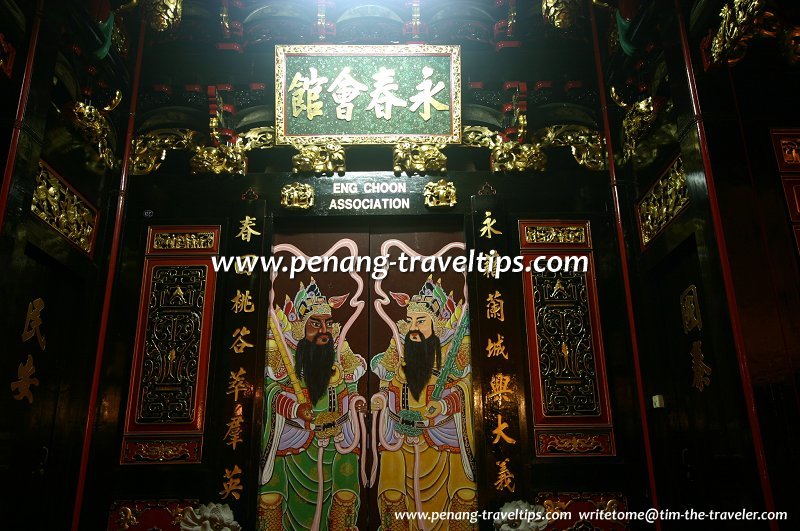 Eng Choon Association, Malacca (9 July 2005)
Eng Choon Association, Malacca (9 July 2005)
Why are the Peranakan who they are? Chinese people emigrate all over the world, even now, why don't they create a new culture as the Peranakan did? The reason is, the Peranakans are a group that underwent a period of isolation. They cut themselves off from the culture of mainland China. Unlike the Sinkheh, they have no aspiration to "tui Tengsua" (go back to China). So, they are like Darwin's finches in the Galapagos. The long period of detachment from their China homeland has resulting in them creating a fusion culture. This does not happen overnight, and the boom years of tin mining is also too swift for creating a new culture. You don't marry a local and start practising Peranakan culture. The Baba Nyonya created their unique traits independent of whether they intermarry. They adopted Malay loan words out of practical purposes, they worshipped local earth spirits out of their own fear of the unknown in their adopted homeland.
"Chinese seafarers have arrived in this part of the world during the Ming Dynasty and even earlier." True. In fact, I have been suspicious about the identity of Hang Li Po, but that's a different story. What we need to ask now is, from where did those early Chinese seafarers come? Are their descendants still living in this land?
Now let's compare with the Peranakans. What language to they speak? A type of Hokkien. From there, we can deduce that their ancestors had Hokkien as their spoken language. Were the early seafarers of the Ming Dynasty Hokkien people? If yes, then that offers a clue or possiblity that they are the ancestors of the Peranakans, particularly of the Peranakan in Malacca.
The Peranakan of Penang and Malacca do not speak the same type of Hokkien. From what I learn, the Hokkien of Penang is closest in resemblance to that of Zhangzhou. I also read somewhere that the Hokkien of Malacca is similar to that of Xiamen. But I could have misread, and I acknowledge that it could be Quanzhou. At time of writing this (Feb 2013), I still need to delve deeper on the similarity of the Hokkien language in Xiamen and Quanzhou, and which closer resembles that of Malacca.
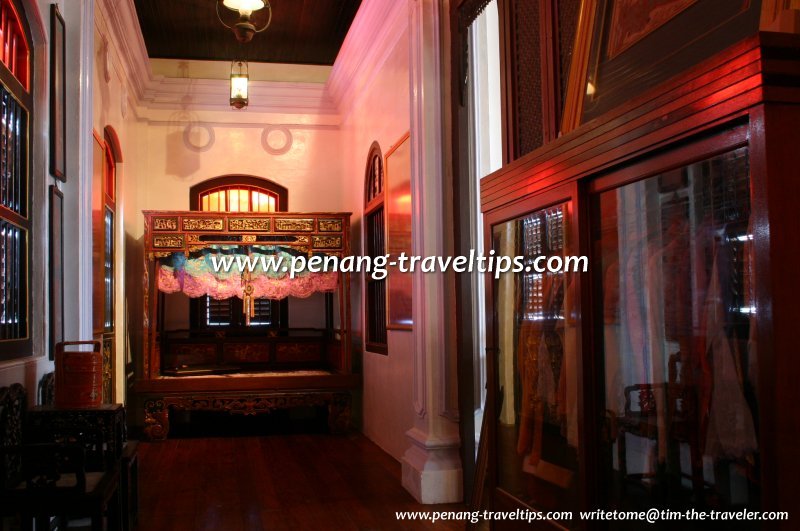 Nyonya bedchamber (21 August 2004)
Nyonya bedchamber (21 August 2004)
The door into and out of China has opened and shut many times in history. After the voyages of Zhenghe, the door did shut once more. What we need to do is to determine which particular group of Chinese were the ancestors of the Peranakans. They have to be significant in number, otherwise they would have been absorbed into the local society. In order to form a culture, they lived together in close proximity over time, isolated from their homeland.
In the past two hundred years, we the local Chinese has been subjected to "generalisation". Instead of being regarded as culturally distinct, the Peranakan of Penang and Malacca are now being lumped together as one. Instead of being Cantonese, Hokkien, Hakka, etc., we are forced into a homogeny as Chinese. This has caused us to lose our heritage and unless we make an effort to call out and celebrate our differences, we shall forget them.
Related Topics on the Penang Baba Nyonya
- Are you Baba Nyonya
What would be the yardstick to determine that a person is a purebred Baba Nyonya or an acculturated Baba Nyonya? Is it by his clothes, the language he speaks, or something else? - Penang Nyonya Dishes
Get to know a selection of local dishes that were inspired by the Baba Nyonya culture. - Penang Nyonya Kuih
Get to know the wide variety of pastries created by the Nyonya. - Penang Nyonya Kitchen
List of ingredients used by the Baba Nyonya to make their dishes and kuih.
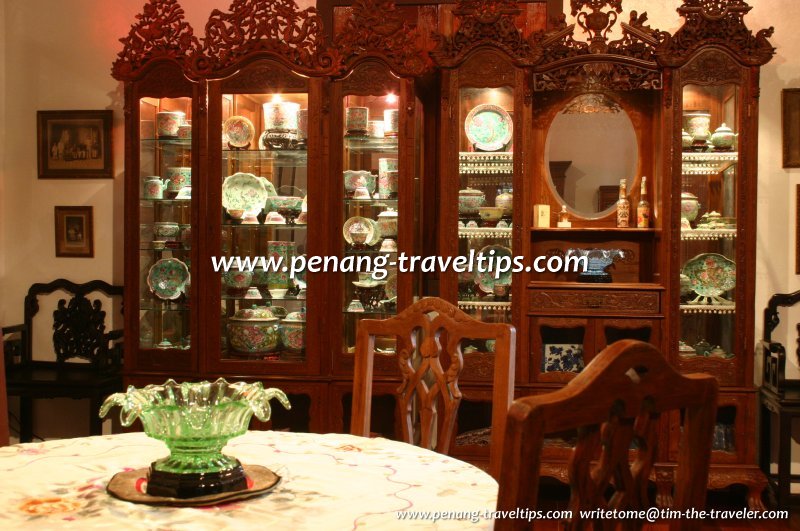 Nyonya porcelain in display cabinet (21 August 2004)
Nyonya porcelain in display cabinet (21 August 2004)
Bibliography
- Chinese History in Geographical Perspective, by Jeff Kyong-McClain & Yongtao Du, Rowman & LIttlefield Publisher, 2013, page 142
- Peranakan's Search for National Identity: Biographical Studies of Seven Indonesian Chinese, by Leo Suryadinata, Marshall Cavendish Academic, 2004

Copyright © 2003-2025 Timothy Tye. All Rights Reserved.

 Go Back
Go Back